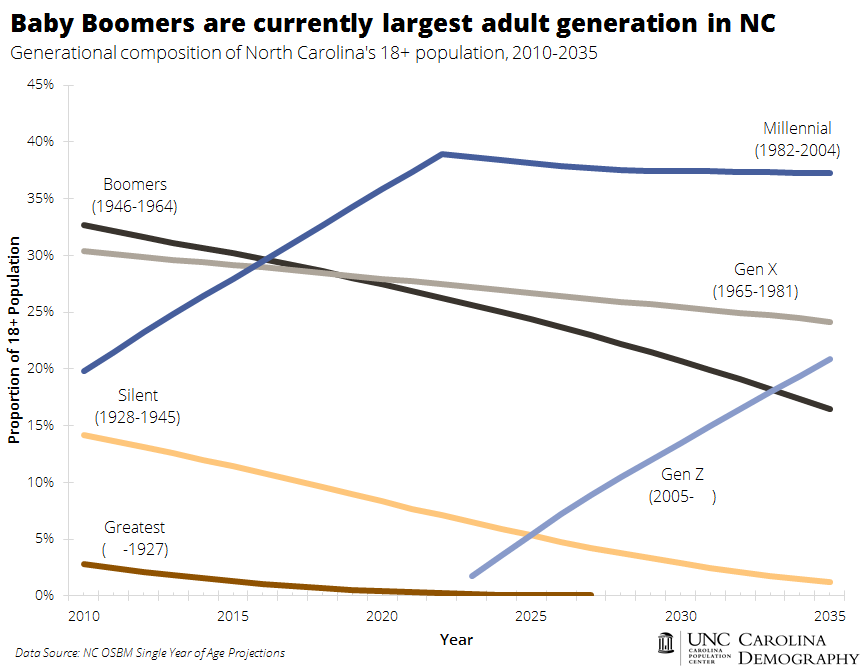“How Millennial Are You?” asked a 2010 quiz from the Pew Research Center. We hear a lot about generations and generational difference, on topics ranging from grocery shopping to television viewing habits to the future of the suburbs. Many of these conversations center on Millennials and Baby Boomers for two reasons. Not only are these the two largest generations alive, they are currently at key points in their lives. The oldest of the Baby Boomers began turning 65 in 2011, meaning that Baby Boomers are entering retirement phases as they are trying to recover from the economic challenges of the Great Recession. At the other end of the spectrum, young Millennials are going to school, starting jobs, and forming families – again, all during the lingering impacts of the Great Recession.
Business analysts and researchers both talk in terms of generations because it is useful for capturing general propensities of a group of people. It’s true that the sweeping generalizations of generational typologies do not apply to all individual members of a generation, but there are insights that can be gained by using generational classifications. First, they capture a group of people who are roughly the same age, meaning they are likely experiencing similar life events. Second, they capture a group of people who have, on the whole, experienced the same set of broader economic, cultural, and technological exposures. Turning 18 in 1970 was a very different experience than turning 18 in 2010, and those experiences shape attitudes, beliefs, and habits in ways that can be meaningful for understanding everything from consumer preferences to political behavior.
There is no universally accepted definition of generations, particularly of the more recent Millennial generation. I’m going to use the following cut points:
Greatest Generation: Born in 1927 or before
Silent Generation: Born 1928-1945
Baby Boomers: Born 1946-1964
Generation X: Born between 1965 and 1981
Millennials: Born between 1982 and 2004
Generation Z: Although this generation has not officially been named yet, Generation Z is occasionally the term used to describe individuals born in 2005 or later (post-Millennials).
As generations age and are replaced by younger generations, there can be profound changes in attitudes and behaviors. The figures below examine the generational composition of North Carolina’s adult (18+) population from 2010-2035 based on single year of age projections produced by the Office of State Budget and Management.
 There were an estimated 7.7 million adults in North Carolina in 2014. With more than 2.3 million individuals, the Baby Boomers are currently the largest adult generation in North Carolina, representing 31% of all adults. Generation X was close behind, with just under 2.3 million or 30% of all North Carolina adults. The Millennials were the third largest adult generation – 2 million or 26% – followed by the Silent Generation (919,000 or 13% of NC adults) and the Greatest generation (118,000 or 2% of NC adults).
There were an estimated 7.7 million adults in North Carolina in 2014. With more than 2.3 million individuals, the Baby Boomers are currently the largest adult generation in North Carolina, representing 31% of all adults. Generation X was close behind, with just under 2.3 million or 30% of all North Carolina adults. The Millennials were the third largest adult generation – 2 million or 26% – followed by the Silent Generation (919,000 or 13% of NC adults) and the Greatest generation (118,000 or 2% of NC adults).
The size of the adult Millennial population will increase rapidly through 2032, the year when all Millennials reach age 18 or older. After this, the state’s Millennial population is projected to continue to grow in size each year from continued net in-migration of Millennials from other states and countries.
Millennials are projected to surpass Generation X as the second largest adult generation in 2016 and to outnumber Baby Boomers by 2017. After this, they will remain the largest adult generation for the coming decades. Their adult population share is projected to peak in 2022, when Millennials will comprise nearly two in every five North Carolina adults.
The Baby Boomer population will experience steady, slow shrinking in coming years due to population aging (although these impacts may be stemmed from retiree in-migration to the state). At the same time, the state projections predict continued growth of Generation X due to net in-migration to North Carolina. Generation X members are projected regain their spot as the second largest generation among North Carolina adults in 2019.
Generation Z, the post-Millennial generation, will begin turning 18 in 2023. Over the coming decades, their share of the state’s adult population will steadily increase. They are projected to surpass Boomers in 2034. By 2035, more than one in every five of North Carolina’s projected 9.7 million adults will be Generation Z.
How will these broader generational shifts impact the electorate in 2016? Read this for a look at how North Carolina might look.
Your support is critical to our mission of measuring, understanding, and predicting population change and its impact. Donate to Carolina Demography today.